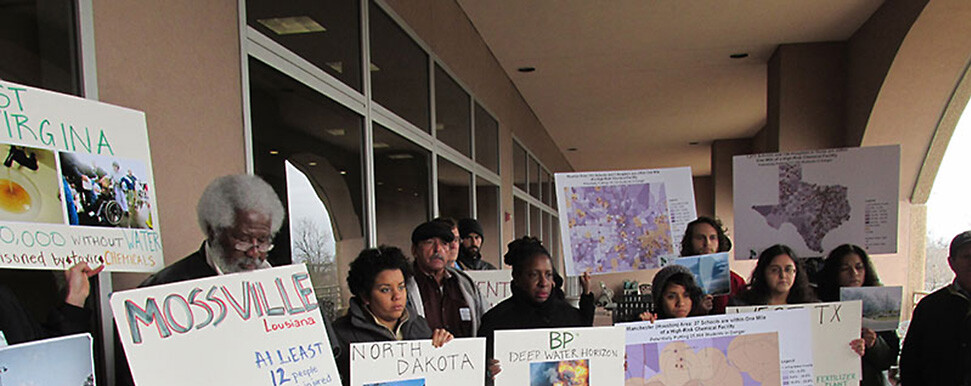
Media
September 20, 2022EPA’s proposed changes to its chemical disaster prevention rule don’t do enough to keep New Jersey communities safe
Profile of Qualco fire and other recent chemical incidents shows need for additional requirements
FOR IMMEDIATE RELEASE
by Coming Clean and the Environmental Justice Health Alliance for Chemical Policy Reform
Press Contact: Deidre Nelms, dnelms@comingcleaninc.org, 802-251-0203 ext. 711
Today, Coming Clean and the Environmental Justice Health Alliance for Chemical Policy Reform (EJHA) released a report that profiles three chemical incidents that occurred within two weeks this January, and recommends specific safety measures that the Environmental Protection Agency (EPA) should require in order to prevent future chemical disasters.
On August 31, 2022, the EPA published proposed revisions to the Risk Management Program (RMP), which regulates approximately 12,000 high-risk facilities in the U.S. that use or store highly hazardous chemicals. EPA was specifically directed by Congress to use this program to prevent disasters, yet more than 140 harmful chemical incidents occur on average every year.
On January 14, 2022, a fire at a warehouse in Passaic, New Jersey came dangerously close to igniting the adjacent Qualco Inc. facility where an estimated 3 million pounds of hazardous chemicals were stored. According to fire officials, this could have caused “one of the most catastrophic chemical disasters in the region in recent history.” Facilities like Qualco Inc. are not currently covered by the EPA’s Risk Management Program despite storing large chemical stockpiles. The facility was therefore not required under the RMP rule to report the hazardous chemicals on site to EPA, conduct a worst-case release scenario analysis, coordinate incident planning with local first responders, or consider measures to prevent a chemical disaster.
This April, Senator Cory Booker and 30 members of Congress urged the EPA to “implement robust prevention and safety standards to prevent chemical disasters,” such as expanding the Risk Management Program to cover more chemicals. But the EPA’s proposed rule declines to take this step.
Preventing Disaster offers actionable recommendations the EPA should include in its final rule that could prevent similar incidents from happening in the future, including:
- Expanding the Risk Management Program to cover additional hazardous chemicals, and lower the thresholds that would trigger coverage for chemicals already included;
- Requiring all RMP facilities to consider, document, and implement safer chemicals and technology;
- Requiring RMP facilities to not only consider the risks posed by natural hazards, as proposed in the draft rule, but to take meaningful steps to prepare for those risks, such as implementing backup power for chemical production and storage processes.
“Overall,” the report concludes, “EPA’s draft rule, rather than adopting common-sense prevention requirements, continues to rely on voluntary actions by high-risk facilities. This approach has failed to prevent many chemical disasters over the last 25 years. If the draft rule is not strengthened, facility workers and neighbors across the country will continue to bear the human, environmental, and financial costs of more preventable disasters.”
“The EPA still has time to get this rule right,” said Steve Taylor, Program Director for Coming Clean, who contributed to the report. “Communities at the fenceline of these hazardous facilities, and the workers inside them, are sick of industry stonewalling and EPA excuses. A stronger rule is needed to ensure that hazards are removed, or we will continue to see more chemical disasters.”
“We’re glad that EPA recognizes the need to reconsider the RMP rule; preventing disasters is a longstanding priority for EJHA. Unfortunately the draft rule is full of more voluntary measures, which decades of incidents have proven do not work.” said Michele Roberts, National Co-Coordinator of the Environmental Justice Health Alliance for Chemical Policy Reform. “We are depending on EPA to have the moral and political courage to keep the promises President Biden has made to our communities— that means a final rule that requires the transition to safer chemicals and processes wherever possible. Removing hazards before disasters can occur is the best way to protect workers and communities.”
Coming Clean and EJHA are part of a broad coalition that includes fenceline community members, health professionals and members of Congress that has urged the EPA to adopt a stronger RMP rule for many years. Members of this coalition will be vocalizing their priorities and concerns on the draft rule at virtual public hearings held by the EPA on September 26, 27 and 28, 2022.
# # #
Coming Clean is a collaborative network of frontline community activists, environmental health and justice organizations, and policy, science and market experts, committed to transforming the chemical industry so that it is no longer a source of harm. For twenty years, we have fought to end legacy pollution in communities of color, ban toxic pesticides that harm farmworkers and their families, regulate hazardous facilities, and end the sale of unsafe products in dollar stores and other retailers across the country. Learn more about our Chemical Disaster Prevention Program.
The Environmental Justice Health Alliance for Chemical Policy Reform is a national network of grassroots Environmental and Economic Justice organizations and advocates in communities that are disproportionately impacted by toxic chemicals from legacy contamination, ongoing exposure to polluting facilities and health-harming chemicals in household products. EJHA supports a just transition towards safer chemicals and a pollution-free economy that leaves no community or worker behind.
